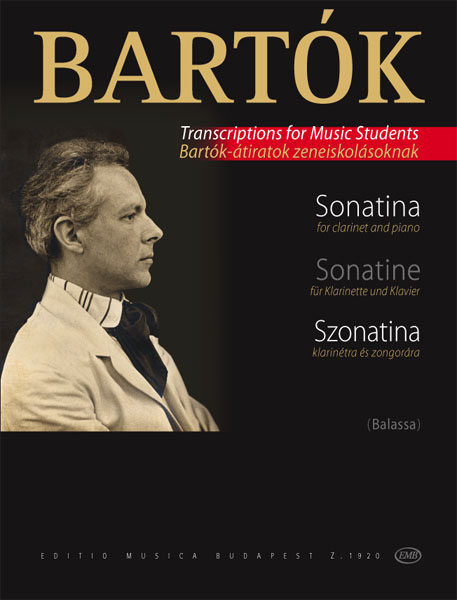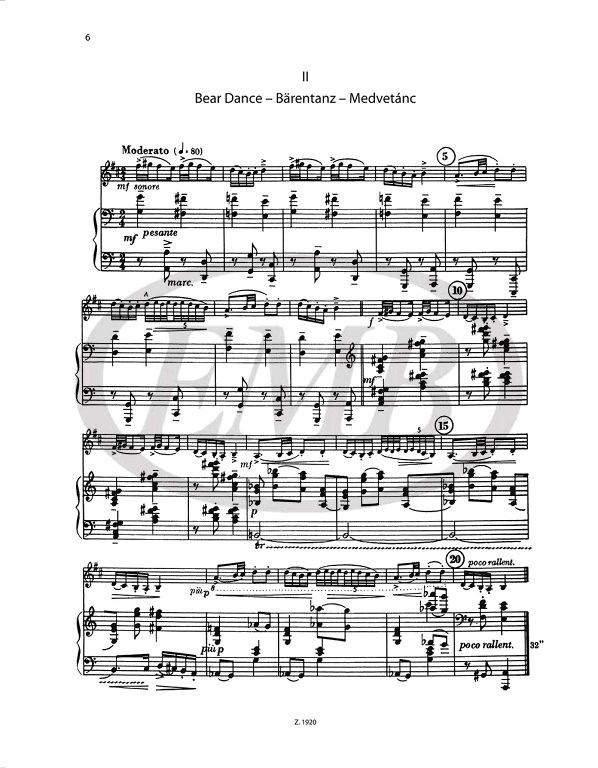Description
Bartók Béla: Sonatina – Clarinet & Piano Transcription (Paperback Sheet Music)
Product Details
- Item Number: 1920
- ISMN: 9790080019207 / 979-0080019207
- Product Type: Paperback Sheet Music
- Setting: Clarinet and Piano
- Series: Bartók Transcriptions for Music Students
- Period: 20th Century
- Length: 16 pages
- Format: Bach (23 x 30,2 cm)
- Weight: 0.081 kg
- Published: 1955
- Publisher: Editio Musica Budapest Zeneműkiadó
- Made in: Hungary
Overview
English:
"Bartók Béla: Sonatina" is a fascinating transcription for clarinet and piano, meticulously prepared by Balassa György. Originally composed for piano in 1915, the Sonatina brilliantly incorporates five authentic Romanian folk dance melodies that Bartók recorded during his folk music collecting journeys in Transylvania between 1910 and 1914. The work is structured in three distinct sections:
- Bagpipers – featuring two bagpipe melodies (ardeleana and joc) from Hunedoara and Bihor.
- Bear Dance – a movement inspired by a peasant violinist’s rendition on the lower strings—intended to evoke the deep rumble of a bear’s voice.
- Finale – utilizing two violin melodies (a turcii and babaleuca) from Mureş and Torontal.
In 1931, Bartók reimagined the piece for orchestra under the title "Dances of Transylvania." Launched as part of the Bartók Transcriptions for Music Students series in 2015, this edition not only revives a classic but also meets the strict aesthetic criteria established by earlier publications, inviting music students into the rich world of one of the twentieth century’s greatest musical geniuses.
Hungarian (Attekintés):
"A Bartók Béla: Szonatina" egy lenyűgöző, klarinét és zongora számára átdolgozott kiadvány, melyet Balassa György készített. A műet eredetileg 1915-ben zongorára komponálták, és öt eredeti román népi táncdallamot ötvöz, melyeket Bartók 1910 és 1914 között, erdélyi gyűjtőútjain rögzített. A zenemű három részre tagolódik:
- Dudások – két dudadallam (ardeleana és joc) alapul, melyek Hunyad és Bihor megyéből származnak.
- Medvetánc – a paraszti hegedűs mély húrokon előadott változatára építve, hogy a medve hangjára emlékeztessen.
- Finale – két hegedűdallam (a turcii és babaleuca) inspirálta a Maros és Torontál megyéiből.
1931-ben Bartók zenekari formában is meghangszerelte a művet "Erdélyi táncok" címmel. A 2015-ben indított „Bartók-átiratok zeneiskolásoknak” sorozat keretében ez az új kiadás nem csupán a klasszikusot eleveníti meg, hanem megfelel a régebbi kiadványokra támasztott szigorú esztétikai követelményeknek, ezzel még több zeneiskolást vezetve be a 20. század egyik legnagyobb zenei géniuszának világába.
Product Features
- Format & Dimensions: Bach (23 x 30,2 cm)
- Page Count: 16 pages
- Weight: 0.081 kg
- Setting: Clarinet and Piano
- Series: Bartók Transcriptions for Music Students
- Period: 20th Century
- Transcription: Prepared by Balassa György
- Historical Relevance: Utilizes five original Romanian instrumental folk dance melodies
- Original Composition Date: 1915 (for piano)
- Later Orchestration: Reimagined as "Dances of Transylvania" in 1931
Interesting Facts
English:
- Folk Influences: Bartók ingeniously integrated five Romanian folk dance melodies—recorded during his trips in Transylvania—into a sonatina originally composed for piano.
- Innovative Adaptation: The first movement is based on bagpipe tunes from Hunedoara and Bihor, while the second, the "Bear Dance," famously reflects the deep tones produced by a peasant violinist, thus simulating the growl of a bear.
- Dual Editions: Not only does this transcription serve as an essential teaching tool in the Bartók Transcriptions for Music Students series, but it also reflects the enduring legacy of Bartók’s works, further enriched by its orchestral version from 1931.
- Series Launch: Released as part of a commemorative series in 2015 marking the 70th anniversary of Bartók’s death, this transcription aims to introduce new generations to his musical genius.
Hungarian (Érdekes Tények):
- Népi Ihlet: Bartók mesterien ötvözte öt román népi táncdallamot – melyeket erdélyi útjai során rögzített – eredetileg zongorára komponált szzonatinában.
- Innovatív Átállítás: Az első tétel Hunyad és Bihor megyéből származó dudadallamokon alapul, míg a "Medvetánc" tételben a paraszti hegedűs által a mély húrokon előadott változat utánozza a medve morgását.
- Kétszeres Kiadvány: Ez az átirat nem csupán a “Bartók-átiratok zeneiskolásoknak” sorozatának alapműve, hanem tükrözi Bartók örökségének állandóságát, amit 1931-es zenekari változata – az "Erdélyi táncok" – is bizonyít.
- Sorozat Indítása: A 2015-ben, Bartók halálának 70. évfordulója alkalmából indított sorozat keretében ez az átirat újabb generációk számára nyitja meg a zenei géniusz világát.
Publishers
Published by Editio Musica Budapest Zeneműkiadó in 1955. All rights reserved under catalog number 1920 and ISMN 9790080019207 / 979-0080019207.
We value your feedback! Share your experience with this product to help others make informed decisions. Your review is important to us!
Hashtags
English:
#BartokBela #Sonatina #BalassaGyorgy #ClarinetPianoSheetMusic #20thCenturyMusic #EditioMusicaBudapest #TranscriptionsForStudents #RomanianFolkMelodies #MusicEducation
Hungarian (Címkék):
#BartókBéla #Szonatina #BalassaGyörgy #KlarinétÉsZongoraKotta #XXSzázadiZene #EditioMusicaBudapest #ÁtiratokZeneiskolásoknak #RománNépdalok #Zeneoktatás



















